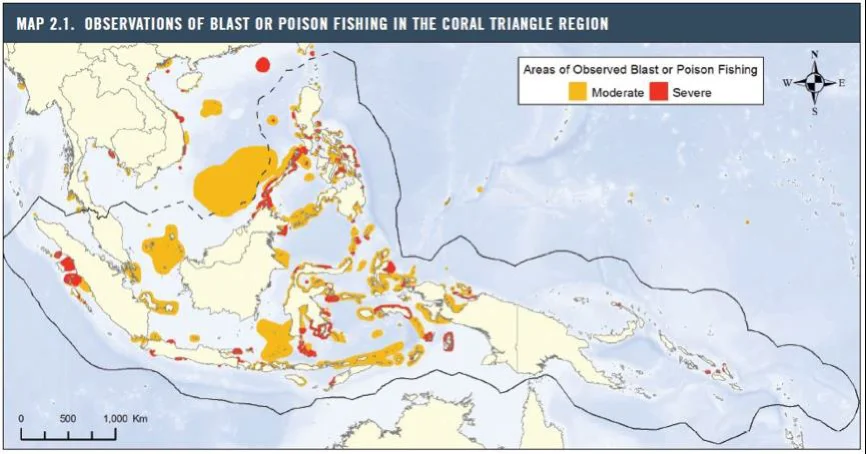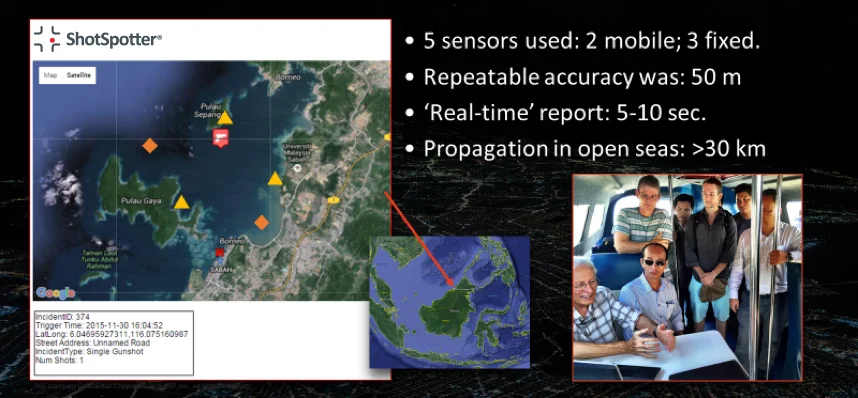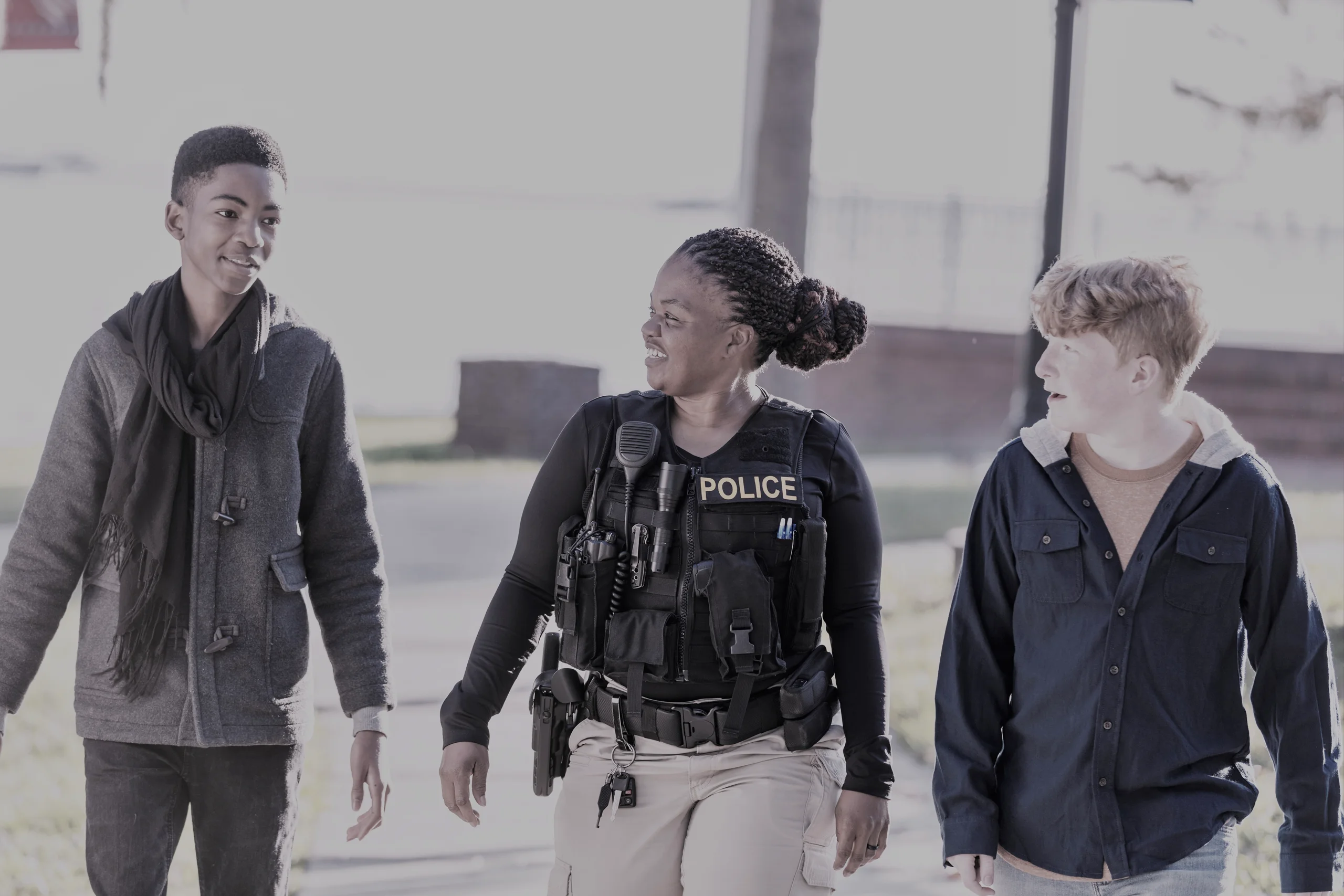SoundThinking™ has two environmental initiatives which have shown great technical promise – protecting rhinos in Africa from poaching and locating blast fishing (a.k.a. dynamite fishing) in the tropics. The poaching initiative will be discussed in another blog while protecting tropical reefs and communities from blast fishing is discussed here.
Blast fishing, scarcely known in Europe and North America, is a pernicious practice threatening a majority of tropical reefs and the food supply of a billion people. In contrast to traditional methods of netting or spearing, fishing with explosives takes advantage of the efficiency of bombing above reef areas. By bombing over the reefs, these practices destroy the reefs and hence the homes of the fish, taking years to recover. The text and figures and videos below give examples of this worldwide scourge.
SoundThinking researchers have been working for six years with the international environmental coalition Stop Fish Bombing (www.sfbusa.org). Our aim is to provide the necessary blast location capability to enable marine law enforcement to intercept those fishing with explosives. In coordination with legal and social reforms, timely reporting of blast locations to law enforcement can help prevent blast fishing.
This map shows one of the most concentrated regions of damage located in the Coral Triangle area of SE Asia. Note that the northern portion of Borneo is in a severely impacted area, and that is where SoundThinking and the Stop Fish Bombing group have done our testing. The area is peppered with small villages that have been threatened by those fishing with explosives. In some cases, they are used as local labor to gather bombed fish, in others the bombers simply take over a village, plundering whatever they want. There is also an industrial angle, as the capability to fill a mothership with hundreds of pounds of fish during a weeklong dynamite fishing expedition becomes attractive on a larger scale.

Due to the remoteness of blast fishing and the limited resources of local governments to counter the threat, the current situation is escalating out of control, with resulting loss of reefs and fish stocks. This threatens the food supply, livelihood, and in the case of Malaysia, a 300-million-dollar tourism industry centered around scuba diving. The image below shows how a reef looks after it is destroyed. The visual demonstrates just how devastating dynamite fishing can be to a pristine reef. Recovery from this type of damage takes decades.
The sequence of events we envision to fight the problem is shown in the next diagram. We are proposing that locating those fishing with explosives in real-time with our BlastSpotter system will allow marine law enforcement forces to interdict blast fishing, and to create a deterrent. Behavior of criminals has shown that the certainty of detection is more important than the severity of punishment.
Marine forces can use boats, drones, radar, and long-range photography to apprehend the blasters. As with our urban systems, actual data of time and location of dynamite fishing can replace the tendency of governmental denial of the problem with a clear avenue for local governments to more effectively expend their resources fighting the problem.
The panel of four photos below is from one of our trips to Sabah, Malaysia (Northern Borneo). Here we successfully tested the ShotSpotter® acoustic method underwater, under the auspices of the Fisheries Department. The man holding the beer-bottle bombs (made with household materials) is about to fuse and toss one of them into the water. The person attending to the BlastSpotter acoustic sensor package in the bow of the boat is a Stop Fish Bombing colleague from Sabah, and the leader of our test. The hydrophone boom was mounted on a pier piling at about mid-water depth, and the fourth photo shows the diver who inspected the sandy bottom area of our test to ensure that no schools of fish were present.

The next panel shows the geometry of the acoustic array in Gaya Bay, where we conducted the test. The results are summarized in text and in a presentation on the command vessel to the head of the Fisheries Department.

Also seen below is a photo of Clark Dunson and Dr. Robert Showen, founder of SoundThinking on the command vessel looking at and appreciating the results of the testing.

Then we moved our equipment several hundred miles to a series of reefs in Northeastern Borneo (just North of the world-renowned Sipadan dive site) where fish blasting was known to occur. The Seaventures scuba platform (former oil rig) was the site of one of the three sensors used, shown as golden crosses in the panel below. The overlapping red map pointers show locations of 2 blasts separated in time and distance by one hour and ½ km. A photograph of the two small fishing boats – likely those fishing with explosives – was taken from the Seaventures platform, 20 m above the water, and a distance of 8 km away.

Below is a photo of Clark Dunson with the Seaventures platform in the background, where he and Terence Lim had just dived to install the underwater acoustic array. To his left you can see the top of one of the acoustic sensors, with two black cellular antennae.

Here is an expanded view of the center of the same audio file showing the blast fishing with its reverberation decay, and its spectra. The horizontal axis is time in seconds, and the vertical axes are arbitrary amplitude and frequency in Hz. Sample rate is 12 kHz, so the maximum frequency available is 6000 Hz.

The denizens of the area where we have been operating are a combination of Malaysian citizens – mostly fishers, the stateless Baja Laut, and Philippine pirates.
(Bajau Laut: colloquially ‘sea gypsies’, see here.)
These indigenous peoples have been residents of this area for a millennium. Here are pictures of a Baja Laut boat and a village. In some cases, they are obvious victims of blast fishing, which ruins the environment they use for fishing. Some of the Baja people oppose and some use blast fishing. Due to pressure of tourism, much from China, the stock of fish is being rapidly depleted.


The “Stop Fish Bombing” coalition has been involved with several governments in the Coral Triangle, including Indonesia, East Timor, Malaysia, and Hong Kong. Additionally, they have participated in US Navy Civilian-Military Security Conventions and are in contact with the US Department of State. In Malaysia, several initiatives to protect the ocean and to use our methods to fight against dynamite fishing are under discussion, including taxing tourism to pay for the BlastSpotter installation and operations. But financing remains the primary obstacle to beginning actual projects.
The coalition’s patron is Jose Ramos-Horta, Nobel peace prize winner in 1996 for helping to free East Timor (https://en.wikipedia.org/wiki/Jos%C3%A9_Ramos-Horta). Sir Robin Christopher is an advisor and related to a Stop Fish Bomber founder (https://www.sourcewatch.org/index.php/Robin_Christopher).
Results of our joint work is described in a scientific paper published in March 2018 in the Marine Pollution Bulletin. The title, Highlights, and Abstract of this paper immediately follow.
_____________________________________________________________________________
Locating fish bomb blasts in real-time using a networked acoustic system
By R.Showen(a) C.Dunson(a) G.H.Woodman(b) S.Christopher(c) T.Lim (c) S.C.Wilson(d)
(a) SoundThinking Inc., Suite 300, 39300 Civic Center Dr., Fremont, CA 94536, USA; (b) Teng Hoi Conservation Organization, Room 1906, 19/F, China Insurance Group Building, 141 Des Voeux Road, Central, Hong Kong; (c) Scubazoo Images Sdn. Bhd., 3, Jalan Nosoob Hungab, 88300 Kota Kinabalu, Sabah, Malaysia; (d) Five Oceans Environmental Services LLC, P.O. Box 660, Postal Code 131, Hamriyah, Oman
Highlights
• Networked underwater acoustic sensors can locate fish blasting in real time.
• Excellent system accuracy and long range of sensors is demonstrated.
• Governments can now more readily suppress the practice of fish blasting.
Abstract
Results are presented of a demonstration of real-time fish blast location in Sabah, Malaysia using a networked hydro acoustic array based on the ShotSpotter gunshot location system. A total of six acoustic sensors – some fixed and others mobile – were deployed at ranges from 1 to 9 km to detect signals from controlled test blasts. This allowed the blast locations to be determined to within 60 m accuracy, and for the calculated locations to be displayed on a map on designated internet-connected computers within 10 s. A smaller three-sensor system was then installed near Semporna in Eastern Sabah that determined the locations of uncontrolled blasts set off by local fishermen. The success of these demonstrations shows that existing technology can be used to protect reefs and permit more effective management of blast fishing activity through improved detection and enforcement measures and enhanced community engagement.
Graphical Abstract

This graphical abstract shows a Blast boat in Gaya Bay used to create underwater blasts to test the ShotSpotter method of location. The blasts were similar in size to what is used by blast fishers who fill a large beer bottle with explosives.
To read the full text of the paper click here.
We are hoping that the arguments made in the paper will convince oceanographers, environmentalists, governments and communities to consider our approach to elimination of the blast fishing culture.




